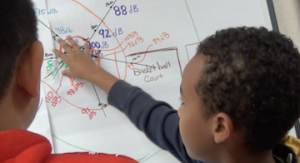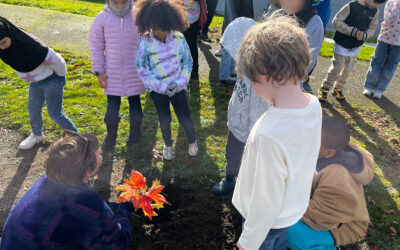 In our elementary series we have three sets of video for you. Can 5, 6, and 7-year olds engage in scientific practices? With the right support they can do amazing things.
In our elementary series we have three sets of video for you. Can 5, 6, and 7-year olds engage in scientific practices? With the right support they can do amazing things.
K-2 Modeling Series
These provide a glimpse inside kindergarten and 1st/2nd-grade classrooms that are developing scientific models to make sense of and more deeply explain a real-world phenomenon over time. The kindergartners in Ms. Tomokiyo’s class at Southern Heights Elementary School in Seattle, Washington, are seeking to understand how a puddle on the grass appears and disappears over the course of a day.
The overview video describes scientific modeling in elementary classrooms and how to support the revision of students’ ideas over time.
In the first strategy video, we see students using share-outs and discussion spotlights to learn from each other. As you watch, think about how share-outs of models can be more than “show and tell.”
The second strategy video shows students engaging in an interactive read-aloud. As you watch, think about how you can use informational texts to support scientific sense-making. Pay special attention to how students critique science ideas and representations from the books.
K-2 Argumentation Series
In our next series, we share key principles and strategies for engaging K-2 students in the practice of scientific argumentation with explanatory models. We join a second-grade scientific community in the midst of exploring a real-life question: What caused the town of Moncton to flood? As they pursue answers to this question, you’ll see that students are not making arguments about isolated observations (e.g., which kind of soil water flows through fastest), but rather arguments that connect to their explanatory models of the phenomenon (the flooding of Moncton). We call this “model-based CER (Claims, Evidence, and Reasoning),” where argumentation occurs in service of developing models of phenomena and supporting deeper, more interconnected science learning.
The overview video shares key principles and strategies for engaging K-2 students in the practice of scientific argumentation with explanatory models.
The first strategy video features how to support students in weighing different forms of evidence (from personal experience, experiments, readings) and using agree-disagree T-charts as a way to support scientific argumentation over the course of a unit of instruction, as a way to validate students’ initial and ongoing ideas.
The second strategy video shows how to integrate sentence-stems in a way that supports argumentation and the development of scientific models, supporting deeper and more interconnected science learning.
Foothold Practices
Our third series we call “foothold” practices for elementary teachers. Footholds refer to beginning routines that teachers use with students, to introduce them to ambitious work (both the teacher and the students). These routines boost participation by students and expand the rigor of the work they can do together, while being manageable for the teacher who is attempting new practices. Teachers then become comfortable with these ways of supporting intellectual work and create variations on these practices, often creating innovations that can get spread throughout the AST Community. Footholds lead to the use of other AST routines that extend the power of these initial practices.
![]()
Try these small shifts in teaching practice with big impacts. Each video is about 7-10 minutes long and is designed to be a quick way to get your toes wet with the Ambitious Science Teaching practices. You will recognize familiar practices (such as using vocabulary or doing gallery walks) but the teachers in these videos are taking these practices one-step further. Each video breaks down the practice by describing the talk, task and tools used and provides teacher tips. Be sure to share your variations of these practices on the AST website!
Scaffolds to make students' initial ideas public
An example of how oral prompts and written scaffolds elicit student thinking by eliciting students’ science ideas at the beginning of a unit which helps the teacher makes future instructional decisions in light of the partial understandings, everyday language, and everyday experiences they share.
- 4th/5th Circuits & Pathways
- Science Teaching Practice: Eliciting Students’ Science Ideas
- NGSS: 4-PS3-2 & 4-PS3-4; Science Practices- developing models)
Responsive talk: How students use vocabulary
Eliciting students’ everyday and academic language to understand how they are initially understanding a science phenomenon. Students use particular vocabulary to communicate their ideas. Teacher chooses to respond by using students’ words, instead of introducing science words, at this point in the unit. Interview with teacher debriefing her decisions included.
- 6th
- Force & Motion (acceleration, momentum, inertia)
- Eliciting Students’ Ideas; Academic Language Science talk, Science Vocabulary
- NGSS: MS-PS2-1 & MS-PS2-2
Using back-pocket questions to make sense of activities
Eliciting students’ everyday and academic language to understand how they are initially understanding a science phenomenon. Students use particular vocabulary to communicate their ideas. Teacher chooses to respond by using students’ words, instead of introducing science words, at this point in the unit. Interview with teacher debriefing her decisions included.
- 6th
- Force & Motion (acceleration, momentum, inertia)
- Eliciting Students’ Ideas; Academic Language Science talk, Science Vocabulary
- NGSS: MS-PS2-1 & MS-PS2-2
Using a gallery walk to critique student models and explanations
Critiquing models and receiving peer review helps students question their own understanding of science concepts and identify gaps in their own understanding This video shows one way for students to give and receive critiques of their evidence-based scientific explanations. For this gallery walk, students will be critiquing each other’s models of flashlight circuits.
- 4th/5th
- Circuits & Pathways
- Developing and Critiquing Models; Revising Student’s initial ideas
Everyday language and science language
Comparing how students use and have heard science terms in their everyday lives with how we use them in science This video shows an example from a 6th grade physics classroom where students are asked to compare how they’ve heard the words speed, velocity, and acceleration used in their everyday lives with how they use them in science.
- 6th
- Force & Motion (acceleration, momentum, inertia)
- Academic Language
- Science talk, Science Vocabulary
- NGSS MS-PS2-1 & MS-PS2-2
Comparing students' science ideas: scaffolding debate
When teaching in a way that is responsive to student ideas, it is unsurprising that students will disagree. Engaging students in productive talk about their disagreement allows students to broaden their understanding about a key science idea. This video provides an example of one way for teachers to engage students in talk that will compare and contrast their opposing hypotheses.
- 4th/5th
- Circuits & Pathways
- Science Teaching Practice: Constructing evidence-based explanations
- NGSS: Science Practice – Debate/Argumentation using evidence
Creating a "Gotta Have" checklist
This video shows how students generate items for the “gotta have” checklist using participation structures such as pair-share along with writing in science notebooks. Students will use items on this checklist to help them write their explanation. This activity can serve as a prewriting activity for writing a scientific explanation
- 4th/5th
- Circuits & Pathways
- Science Teaching Practice: Constructing Evidence-based explanation
- NGSS: Science Practice – Constructing Evidence-based explanation
Using models to develop a scientific explanation: A sound unit overview
Developing and revising models during a science unit helps students recognize how their thinking has changed overtime in light of evidence from classroom activities. This video shows an overview of a 3rd grade Sound Unit from Day 1 where students develop their initial models about a phenomenon (“Why can a singer shatter a glass with his voice?”), to a mid-point where students revise their model using more detail, and finally how they work in groups to construct a full explanation of the phenomenon using sentence starters to scaffold writing claims with evidence.




 This site is primarily funded by the National Science Foundation (NSF) through Award #1907471 and #1315995
This site is primarily funded by the National Science Foundation (NSF) through Award #1907471 and #1315995